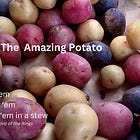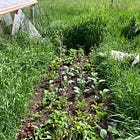Maximizing The Nutritional Benefits of Gardening - tips to consider
The freshest fresh food around
Garden centers are now bursting with an amazing selection of beautiful baby plants just waiting to go home with you to your garden. In the dizzy array of color and varieties, it can be hard to make wise decisions on what to devote your garden space to.
Because let’s face it. Most of us don’t have endless amounts of garden space. And even if we have a lot of space, we don’t necessarily have a lot of time. That means making the most of your garden with an eye to what is going to give you the best bang for your buck.
Let’s take a look at the ways in which you can maximize the nutritional benefits from your garden, while there is still time to decide what is will be planted where.
Vitamin D
You obtain your first nutritional benefit of gardening long before any plant is ready to harvest. This one comes free from sunlight on your skin.
According to this paper in Environmental Health Perspectives (2008) 30 minutes of sunshine can produce anywhere from 8,000 to 50,000 IU of Vitamin D, depending on home much skin you expose while outside.
Vitamin D is critical for the absorption of calcium, and plays a major role in our immune system. So thank you garden! Because this freebie is vital to good health and longevity.
Starchy and Non-Starchy Vegetables
Eating vegetables contributes critical vitamins, minerals, and plant chemicals (phytonutrients) to your diet. Humans are omnivores based on our biology which means we evolved eating both plants and animals as a regular part of our diets.
Vegetables can help you manage conditions like high blood pressure and diabetes, lower your risk of heart disease and stroke, and contribute to a healthy functioning digestive system.
You can think of vegetables as falling into either the starchy or non-starchy category.
Starchy vegetables
Starchy vegetables are higher in carbohydrates and calories, and some are high in protein. Potatoes are the typical example of a starchy vegetable, but beans, peas, lentils, winter squash (e.g. butternut, acorn, Hubbard), and sweet potatoes are also starchy.
If you are worried about food prices and having food that lasts through the winter, then many starchy vegetables fit this bill. They are high-value survival foods that have been staples in the human diet for centuries.
And while we are on this subject, potatoes have gotten a bad wrap for being starchy and yet humans have eaten wild potatoes for thousands of years. So for everyone avoiding potatoes as bad (but snacking on potato chips??) remember that it takes about 1 pound of potatoes to make a bag of potato chips (that is usually 4 or 5 potatoes!). This fact is what got me to stop eating chips! When was the last time you sat down and ate 4 potatoes?
Most of the starchy vegetables are very easy to grow, although some take up a lot of space. I talk about how to grow potatoes in this post:
Non-starchy vegetables
The rest of the vegetables are essentially considered to be non-starchy. They are higher in fiber, lower in calories, and often sweeter than starchy types. This means you can a lot of them and still be on track with managing your weight and overall health.
Brassicas (broccoli, cabbage, cauliflower, etc.), tomatoes, peppers, salad greens, carrots, beets, onions, celery, mushrooms, and summer squash are all considered non-starchy vegetables.
Interestingly, sprouts (and microgreens) are also considered non-starchy, including bean sprouts.
Cooked or raw, non-starchy vegetables contribute significant vitamins, minerals, and antioxidants to your diet.
But what should you grow?
The key message here is that humans are OMNIVORES - and that means we need to eat a varied diet.
There is no single super-food vegetable that will magically confer long life and health.
We need to eat a variety of vegetables, starchy and non-starchy, green and colorful, fast and slow growing, to maximize our nutrition.
And luckily, we can do that pretty easily in our gardens.
Think about your main reasons for growing a garden in the first place. If it’s the high cost of food and survival then the starchy, protein-rich foods are worthy of a lot of garden space.
If it’s more about eating fresh daily, then grow more of the non-starchy foods that generate a wider variety of phytonutrients through their rich colors. Eating the rainbow (in terms of color spectrum) is one way to ensure you are taking in all the potential nutrients out there.
Keep It Fresh
The most important consideration for nutrition and gardening is what will you be able to grow and use fresh (or process - freeze, dry, can - immediately after harvest).
It is pointless to grow food you won’t eat. I know that sounds dumb to say out loud, but seriously I kept growing Swiss chard for years even though no one in the family ever really liked it, mostly because all the gardening magazines at the time said to grow Swiss chard.
Now instead I grow Pac Choi, kale, and beets for that kind of fleshy greens that can be eaten raw or cooked - and I love these so much more than chard. Not to dismiss chard in any way - it’s just I didn’t like it and so it never got used.
The most important part of gardening and nutrition is the zero turn around time between harvest and eating. It is the maximum fresh, maximum nutrition, maximum benefit side of gardening. Missing out on this part is tragic.
So think realistically about how much you need based on how you intend to use it.
If you want fresh salad every night, then don’t empty the seed packet in the row this weekend and call it a job done. Learn to succession plant.
And if you want to feed your family for more of the year, then start considering how much of which vegetables you are eating and make that plan. It’s not impossible. It just takes a strategy.
Garden to table
As your garden becomes ready for harvest, the truly great reward is enjoying those fresh vegetables in your favorite meals. You are getting the best vitamin, the best mineral, and the best immune-boosting “supplements” on the planet when you eat fresh vegetables grown in living soil.
Vegetables provide significant amounts of minerals like calcium, potassium, magnesium and iron. They are rich in Vitamins A, C, E and K. And many are a good source of plant protein.
It simply doesn’t get any better than a diet rich in garden to table foods.
Happy gardening!
The Naturalized Human brings together the science and human experience of the mind-body-food connection. I hope you stick around and become part of this community seeking to understand how the food we eat, and the environments we live in, impact everything about our minds and bodies.










Fantastic post, though we love swiss chard!